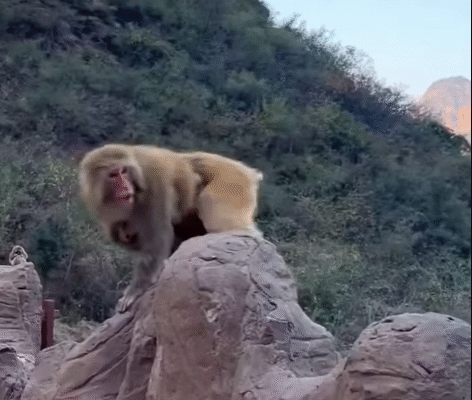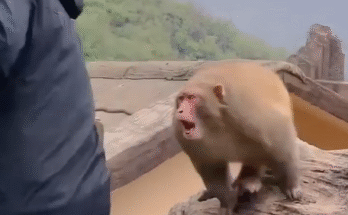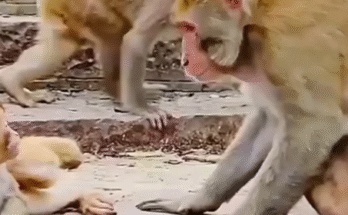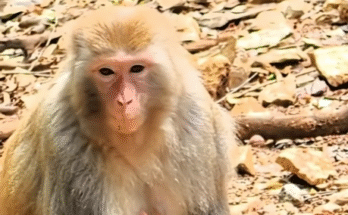
In the wild, survival is a daily struggle, a constant balance between danger and safety. Among the countless strategies animals employ to protect their young, one of the most primal and instinctive is the act of flight. For a mother monkey, the bond with her baby is unbreakable, and her protective instincts are fierce. When she senses threat or danger, there is no hesitation—she will grab her baby and run, leaping, swinging, and maneuvering through the forest with astonishing speed and agility. This story is not just about fear; it’s about love, instinct, and the remarkable lengths a mother will go to protect her child.
The Scene in the Forest
It was early morning in the dense rainforest. The sunlight filtered softly through the canopy, casting dappled patterns on the forest floor. Birds chirped, insects buzzed, and a gentle breeze rustled the leaves. In the midst of this serene setting, a mother monkey sat quietly with her infant clinging to her chest. The baby was no bigger than a small loaf of bread, its tiny hands gripping the soft fur of the mother’s chest as it surveyed the world with wide, curious eyes.
Life in the wild is not gentle for babies. Predators, sudden storms, and territorial disputes can turn a peaceful day into a matter of life and death. A mother monkey knows this, and her senses are always alert. The slightest rustle, the shadow of movement, or an unfamiliar sound triggers a cascade of instincts.
The Warning Signs
In this moment, the mother sensed something unusual. The underbrush shifted oddly, a sound out of place among the natural rhythm of the forest. Her ears perked, her gaze sharpened, and her body tensed. She was ready. The infant, too young to understand danger, clung tightly, trusting completely in the warmth and safety of her mother’s chest.
This is where instinct overrides thought. The mother’s mind calculated the situation in milliseconds: the safest response, the quickest escape route, the path that would keep her baby out of harm’s way. There was no hesitation—only movement, precision, and the fierce drive to protect.
The Flight Begins

Suddenly, without warning, she grabbed her baby firmly, wrapping her arms around it like a protective shield. Her legs moved quickly, leaping from branch to branch, her tail aiding balance as she swung through the trees. The forest blurred around her, a tunnel of green and brown, as she accelerated with remarkable agility.
The baby, startled at first, clung even tighter. Its tiny hands and feet wrapped around its mother, instinctively knowing that she was its lifeline. Every leap, every grasp of the branches, every sprint through the forest floor was a lesson in trust and survival.
The Physical Strength of a Mother
It is easy to underestimate the physical strength and skill of a mother monkey. Carrying a baby while running or leaping through uneven terrain requires extraordinary coordination, balance, and endurance. Each jump is precise, calculated, and executed with the confidence of experience.
As she ran, her muscles worked in harmony—the arms gripping, the legs pushing off branches, the tail stabilizing. The forest floor, often littered with roots, rocks, and uneven terrain, demanded constant adjustment. Any slip could be dangerous, yet the mother moved with a combination of power and grace that seemed almost choreographed.
Her determination was fueled not just by fear but by love. Every movement was for the baby’s safety, a living demonstration of the primal bond between parent and child.
The Baby’s Perspective
From the baby’s point of view, the experience was both terrifying and exhilarating. It felt the rush of wind against fur, the rhythmic swinging of its mother’s body, and the rapid heartbeat that echoed against its chest. Its tiny fingers held on, trusting implicitly that the mother knew what to do.
Even in the midst of panic, there is learning. The baby’s muscles were engaged, its grip strengthened, and its awareness heightened. It was experiencing, for the first time, lessons in trust, survival, and resilience—an education that no other environment could provide.
The Importance of Escape
Flight is not just a physical necessity—it is a survival strategy. In the wild, predators are constantly on the lookout for the vulnerable, and infants are the easiest targets. By running, climbing, or leaping, the mother ensures that her baby is shielded from immediate danger.
Moreover, these actions reinforce social bonds and trust. The infant learns that its mother is a source of protection and that survival often depends on speed, agility, and presence of mind. Over time, these repeated experiences strengthen both body and mind, preparing the young monkey for independence.
A Temporary Refuge

After several minutes of rapid movement through the forest, the mother slowed, finding a safer location—perhaps a dense cluster of trees or a high branch overlooking the forest floor. She settled, still holding her baby close, and assessed the situation.
The baby, though shaken, clung to her chest, comforted by warmth, rhythm, and safety. In these moments of calm, the baby learned another lesson: even in the face of danger, there is security in protection, and resilience grows from care.
The mother, too, paused to catch her breath, her body still tense and alert. Survival in the wild is not just about immediate action—it requires recovery, vigilance, and planning. She had successfully navigated the danger, proving the effectiveness of instinct and maternal care.
The Lessons of Motherhood in the Wild
Observing a mother monkey grab her baby and run provides profound insights into the natural world. Parenting in the wild is a delicate balance between protection, teaching, and preparation. Every action has a purpose: strengthening limbs, sharpening reflexes, and instilling trust.
The tough decisions a mother makes are not arbitrary—they are evolutionary strategies designed to maximize the infant’s chance of survival. While humans often shield children from every minor danger, nature teaches that resilience comes from experience, and sometimes that experience is delivered through adrenaline and challenge.
The Emotional Bond
Beyond the physical, these moments illustrate the depth of emotional connection. The mother’s attachment to her infant is visceral, immediate, and unbreakable. She responds to threats instinctively, guided by the bond that has formed since birth.
The baby, too, learns attachment, trust, and reliance. These seconds, fraught with intensity and urgency, also nurture empathy, emotional awareness, and the understanding that care and protection are constants in life.
A Glimpse into Nature’s Wisdom
Watching a mother monkey act with such urgency and dedication reminds us of the sophistication of the natural world. Every leap, every grasp, every decision is informed by millions of years of evolution. The mother is both teacher and protector, guiding her infant through a complex world with courage and precision.
Her actions highlight the importance of instinct, intelligence, and love in survival. They also remind us of the universality of parental care across species—how every creature, from monkeys to humans, instinctively works to protect its young.
Conclusion
The sight of a mother monkey grabbing her baby and running is both dramatic and deeply moving. It is a story of courage, love, and survival in its purest form. Through this act, the mother not only protects but teaches, strengthens, and prepares her infant for the challenges ahead.
In the wild, every second counts, and every action has meaning. The mother’s flight through the forest demonstrates that love is active, powerful, and sometimes intense. It is not simply affection—it is protection, education, and preparation for life itself.
For observers, this moment is a reminder of the enduring strength of maternal instinct, the importance of resilience, and the extraordinary lengths a parent will go to ensure the safety and growth of a child. In the swift, fearless actions of the mother monkey, we see the timeless truth of nature: survival, love, and care are inseparable, and sometimes, the fastest way to protect is simply to run.



